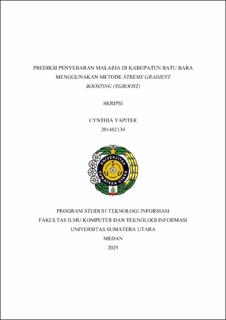| dc.description.abstract | Malaria is a deadly disease transmitted through mosquitoe bites especially that of female Anopheles mosquitoes. It remains one of the world’s infectious diseases with a high mortality rate even as of today. According to data from the World Health Organization, an estimated 249 million malaria cases were recorded across 85 malaria-endemic countries globally in 2022, with Indonesia being the second-largest contributor in Southeast Asia, following India, with a total of 811,636 positive malaria cases. Meanwhile, data from Indonesia's Ministry of Health showed a 32.29% increase in malaria cases in Indonesia in 2022 compared to the previous year. Although 22 out of 33 districts in North Sumatra have been declared malaria-free, malaria cases still frequently occur in areas with difficult-to-reach geographical conditions, one of which is Batu Bara Regency. Batu Bara Regency is classified as a region with a moderate level of endemicity in North Sumatra. In addition to mobility factors, climatic factors such as temperature, humidity, rainfall, and others also significantly influence the spread of malaria. In order to support the government's national goal of eradicating malaria by 2030, there is a need for a predictive model that can accurately forecast the spread of malaria so that swift and effective interventions can be implemented. This study employs the eXtreme Gradient Boosting (XGBoost) model to predict the weekly spread of malaria in Batu Bara Regency, North Sumatra. The researcher also performed data synthesis using TimeGAN to generate data from 2015 to 2018, effectively doubling the total dataset. The most optimal model produced test results with MAE, RMSE, MSE, and R2 values of 2.712, 3.905, 15.251, and 0.806, respectively. The model parameters used include a colsample_bytree of 0.9, learning_rate of 0.1, max_depth of 5, n_estimators of 100, subsample of 0.6, and a data split ratio of 6:4 | en_US |


